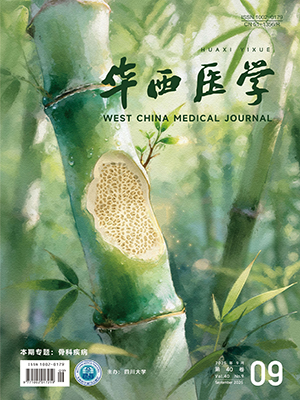【摘要】 目的 探讨胰管结石的诊断和治疗方法。 方法 回顾性分析2000年1月-2009年1月收治的50例胰管结石患者临床资料。其中男37例,女13例;年龄36~70岁,平均49岁。病程7 d~10年,平均6.8年。46例出现腹正中及左上腹间歇疼痛,伴腰背部放射痛。50例均行B型超声和CT检查,诊断阳性率分别为90%(45/50)和96%(48/50);27例行磁共振胰胆管成像检查,诊断阳性率为92.6%(25/27)。所有患者均行手术治疗,包括胰十二指肠切除术8例;胰管切开取石、胰空肠Roux-Y吻合术42例,同时行胆囊切除术12例,Oddi括约肌切开、T管引流术6例,胆肠Roux-Y吻合术2例。 结果 所有患者均取出胰管结石,结石大小为0.2~2.0 cm,结石数目为1~50枚。1例患者术后发生切口感染,经积极抗感染及伤口换药处理后治愈。46例治愈出院,2例好转出院, 2例术后出现并发症死亡。术后40例获随访,随访时间1~48个月,平均24个月。随访期间2例胰管结石伴胰头癌患者因术后胰头癌复发死亡。余38例中有8例术后胰管结石复发,再次行手术治疗后治愈;其中有2例术后仍有腹痛,但较术前有明显好转。 结论 影像学检查是诊断胰管结石的重要手段,准确率高,一旦诊断应根据合并症和胰管扩张程度选择合适的手术方式,可取得良好治疗效果。
【Abstract】 Objective To investigate the diagnosis and treatment methods for pancreatolithiasis. Methods The clinical data of 50 patients with pancreatolithiasis from January 2000 to January 2009 were retrospectively analyzed. Among them, there were 37 males and 13 females aged between 36 and 70 averaging at 49.3. The course of the diseases ranged from 7 days to 10 years with an average time period of 6.8 years. Forty-six patients had intermittent pain in the median abdomen and left upper quadrant combined by ectopic pain in the back. Various image examinations including abdomen ultrasonography, CT scan, and magnetic resonance cholangiopancreatography (MRCP) were performed in 50, 50, and 27 patients, respectively. Pancreatic duct stones were found in 45 of 50 cases (90%) with ultrasonograhy, 48 of 50 cases (96%) with CT scan, and 25 of 27 cases (92.5%) with MRCP. All patients received surgeries including 8 cases of pancreatodudenectomy, 42 cases of pancreatolithotomy plus side to side pancreatojejunostomy. At the same time, there were 12 cases of cholecystectomy, 6 cases of sphincterotomy and T-duct drainage, and 2 cases of Roux-Y anastomosis. Results Pancreatic duct stones were successfully removed in all cases, and the size of the stones ranged from 0.2 to 2.0 cm in diameter. The number of stones removed from each patient ranged from 1 to 50. Symptoms of all patients ameliorated obviously. One patient had incision infection after surgery, and recovered through active antibiotic treatment. Forty-six patients were cured and discharged from the hospital; 2 patients had their conditions improved and were discharged from the hospital; and the other 2 patients died of postoperative complications. Forty patients were followed up for 1 to 48 months with an average time of 24 months. During the follow-up, 2 patients with pancreatolithiasis and carcinoma of head of pancreas died of the recurrence of the cancer. Eight patients had recurrence of pancreatic stones and were cured after a second operation. Among the 8 cured patients, 2 still had abdominal pain, but their conditions were greatly improved after surgery. Conclusion Imaging techniques are important methods in diagnosing pancreatolithiasis with a high precision. Once the diagnosis of pancreatolithiasis is made, surgical procedures should be selected according to the combined diseases and the level of pancreatic duct dilation.
Citation: GAN Yu,LI Ning,LU Wenzhu,CHEN Jianyu. Diagnosis and Treatment of Pancreatolithiasis. West China Medical Journal, 2011, 26(8): 1170-1173. doi: Copy
Copyright © the editorial department of West China Medical Journal of West China Medical Publisher. All rights reserved




